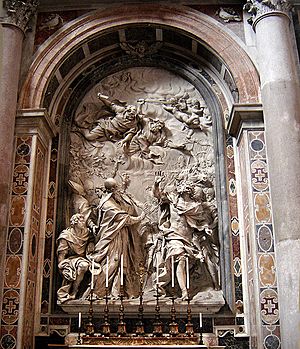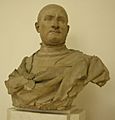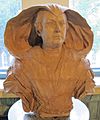Alessandro Algardi facts for kids
Quick facts for kids
Alessandro Algardi
|
|
|---|---|
| Born | July 31, 1598 |
| Died | June 10, 1654 (aged 55) |
| Nationality | Italian |
| Known for | Sculpture |
| Movement | Baroque |
Alessandro Algardi (born July 31, 1598 – died June 10, 1654) was a famous Italian sculptor. He worked mostly in Rome during the Baroque period. For many years, he was one of the main rivals of another famous sculptor, Gian Lorenzo Bernini. Today, people admire his portrait busts (sculptures of heads and shoulders) because they look very lively and important.
Contents
Early Life and Training
Alessandro Algardi was born in Bologna, Italy. When he was young, he started learning art in the studio of Agostino Carracci, a well-known painter. But Alessandro was especially good at sculpture, so he began working for a sculptor named Giulio Cesare Conventi.
His first known works were two chalk statues of saints in Bologna. By the time he was twenty, a powerful ruler, Ferdinando I, Duke of Mantua, started asking him to create sculptures. He also designed figures for local jewelers. After a short time in Venice, Algardi moved to Rome in 1625. There, he helped fix old statues for Cardinal Ludovico Ludovisi.
Becoming Famous in Rome
For almost ten years, Algardi found it hard to get big jobs in Rome. This was because Gian Lorenzo Bernini and his team were getting most of the important sculpture projects. Algardi's friends, like the artists Pietro da Cortona and Domenichino, helped him.
At first, Algardi made smaller works like crucifixes and portrait busts (sculptures of heads and shoulders) out of clay and marble. In the 1630s, he worked on tombs for the Mellini family in the Mellini Chapel in Santa Maria del Popolo church.
The Tomb of Pope Leo XI
Algardi's first really big project came in 1634. Cardinal Ubaldini asked him to create a monument for his great-uncle, Pope Leo XI. This pope had only been in charge for less than a month in 1605. Algardi started the monument in 1640 and finished most of it by 1644.
The monument looks a bit like Bernini's tomb for Pope Urban VIII. It has a large statue of the pope sitting and giving a blessing. Below him, two female figures stand next to his coffin. These figures represent "Magnanimity" (greatness of spirit) and "Liberality" (generosity). Algardi's tomb is calmer and less dramatic than Bernini's. The figures look noble and peaceful.
Other Important Works
Between 1635 and 1638, Algardi created a huge statue of Philip Neri with kneeling angels for the church of Santa Maria in Vallicella. He also made a sculpture group showing the beheading of Saint Paul for a church in Bologna. This group shows a kneeling saint and an executioner ready to strike.
These works helped Algardi become well-known. He also made two famous reliefs (sculptures that stick out from a flat surface): The Martyrdom of St Paul and The Rest on the Flight into Egypt. Algardi's sculptures often show strong feelings, but they are usually more serious and controlled than Bernini's.
Working for Pope Innocent X
When Pope Urban VIII died in 1644, the new pope, Pope Innocent X, took over. This change was good for Algardi. The new pope and his nephew, Camillo Pamphilj, really liked Algardi's work.
Algardi's portraits were highly valued. They looked very serious and formal, which was different from Bernini's more lively style. A large bronze statue of Pope Innocent X by Algardi can now be seen in the Capitoline Museums.
Algardi also helped with the design of the papal villa, the Villa Pamphili (now Villa Doria Pamphili), in Rome. This villa was built to show off the Pamphili family's collection of old and new sculptures. Algardi helped choose and arrange these artworks. He also created fountains and other garden features for the villa.
Works for Spain
In 1650, Algardi met the famous Spanish painter Diego Velázquez. Velázquez helped Algardi get jobs in Spain. Because of this, there are four fireplace sculptures by Algardi in the Royal Palace of Aranjuez. Also, the figures on the Neptune fountain in the palace gardens are by him. Algardi also created the tomb of the Count and Countess de Monterey in a monastery in Salamanca, Spain.
The Flight of Attila Relief
One of Algardi's most famous works is a large, dramatic marble relief called Fuga d'Attila (or Flight of Attila). He worked on it from 1646 to 1653 for St. Peter's Basilica. This artwork helped bring back the use of large marble reliefs in churches.
The relief shows a historical story where Pope Leo I (the first pope to be called "the Great") used divine help to stop Attila and his Huns from attacking Rome. In the sculpture, the brave pope and the scared Attila seem to leap out from the center. Only they can see the angels appearing to help the pope. This scene shows a moment when God steps in to help people. The message was that the pope had the power to call on God's help against enemies.
In his later years, Algardi had a large workshop and became very wealthy. His students, including Ercole Ferrata, Domenico Guidi, and Antonio Raggi, continued his style. Algardi died in Rome in 1654, shortly after finishing his famous relief.
Algardi's Artistic Style
Algardi was especially known for his portrait busts. He paid great attention to small details of people's faces, showing their personality. He also carefully sculpted their clothes and draperies. Examples include the busts of Laudivio Zacchia and Camillo Pamphilj.
His style was more calm and classical compared to the very emotional works of some other Baroque artists. He was very good at making portrait statues and groups of children, where he could follow nature closely. His clay models were also highly valued by art collectors. Many of these models are now in the Hermitage Museum in Saint Petersburg.
Gallery
See also
 In Spanish: Alessandro Algardi para niños
In Spanish: Alessandro Algardi para niños








